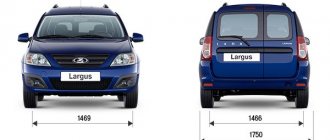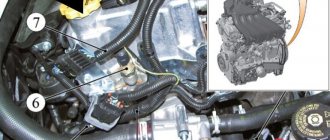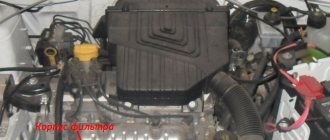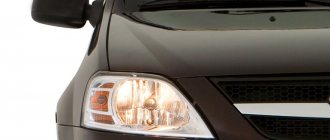Cars admin26.02.2020
During its entire production period, Lada Largus was equipped with only two manual gearboxes: at first the JH3 was installed with the base engine, and the remaining engines were mated to the JR5. For quite some time now there have been rumors about installing a domestic transmission on this car.
This box was first installed on models equipped with an 8-valve K7M engine. This transmission is characterized by very rough operation due to the peculiarities of its design: it is controlled by a rigid rod, hence its excessive noise and vibration. The clutch drive is organized in the old fashioned way - with a regular cable. But reliability is at its best.
JH3-540
| home | 1st | 2nd | 3rd | 4th | 5th | Rear |
| 4.214 | 3.727 | 2.048 | 1.393 | 1.029 | 0.820 | 3.545 |
And this is a modern budget transmission, controlled by two cables and a hydraulic clutch, which is also adapted for the Largus station wagon. Manual transmissions have their pros and cons: on the one hand, unclear shifts and periodic problems with engaging the rear, on the other hand, long gear ratios allow you to drive for a long time in one gear and shift less often. Of the most common breakdowns, drivers remember only a frayed control cable, but replacing it is simple and inexpensive.
JR5-517
| home | 1st | 2nd | 3rd | 4th | 5th | Rear |
| 4.928 | 3.727 | 2.048 | 1.321 | 0.971 | 0.738 | 3.545 |
JR5-549
| home | 1st | 2nd | 3rd | 4th | 5th | Rear |
| 4.214 | 3.727 | 2.048 | 1.393 | 1.097 | 0.892 | 3.545 |
JR5-551
| home | 1st | 2nd | 3rd | 4th | 5th | Rear |
| 4.500 | 3.727 | 2.048 | 1.321 | 0.971 | 0.795 | 3.545 |
The assembly of both types of transmissions was organized at AvtoVAZ. However, the JH3 was abandoned back in 2015, due to the replacement of the French Renault K7M internal combustion engine with the domestic VAZ 11189.
Despite the manufacturer’s assurances, the gearbox oil needs to be changed every 60 thousand km. And do not forget to monitor the level; leaks from the seals are not uncommon for this box. Tranself TRJ 75W-80 branded lubricant was filled from the factory, keep this in mind when adding.
An interesting video about how to change the oil in a Lada Largus car.
From October 2022, the Lada Largus station wagon received a new 16 valve engine with 106 hp. Until this moment, a 16-valve unit with a power of 102 hp was installed under the hood of the car. In fact, the Lada Largus replaced the Renault K4M engine known from Renault Logan with the domestically developed VAZ-21129 engine, which can be found on the Lada Vesta, Granta and Kalina.
Structurally, the new engine for Largus is an in-line 4-cylinder 16-valve engine with a cast-iron cylinder block and a timing belt. The motor does not have hydraulic compensators. But the “French” flame engine had hydraulic compensators, but essentially the same cast iron and timing belt.
The domestic engine is more reliable and does not require high-quality fuel. The manufacturer announced the consumption of AI-92 gasoline. According to Avtovaz engineers, the new engine for Largus will make the car a little more economical and more dynamic. Actually, not so long ago, the Togliatti auto giant abandoned the French 8-valve K7M engine in favor of the same Russian version of the 8-valve VAZ-11189 engine.
LADA Largus with 106 hp LADA engine. is equipped with an upgraded Renault manual gearbox, designed specifically for the new engine. The gear ratios of the third, fourth and fifth gears have been changed. The new power unit allows dynamic driving at lower engine speeds, while increasing acoustic comfort and reducing fuel consumption. The upgraded gearbox is installed on all models of the Largus family with 16-valve engines.
The price of the LADA Largus with the new engine has not changed: the station wagon costs from 635,400 rubles, the van – from 609,800 rubles, the LADA Largus Cross version – from 689,900 rubles. This is the cost of models without all sorts of discounts, with which the car will cost much less.
Lada Largus
Over time, you get used to the shortcomings of the car you drive all the time. But there are exceptions to the rules. For two years now I have been using the Lada-Largus editorial station wagon and still cannot accept the heart-rending roar of its engine on country roads. On a long journey, you get tired of this tedious monologue, and the rising tachometer needle puts pressure not only on the psyche: you constantly think about increased fuel consumption. Judging by the numerous unflattering comments on thematic Internet forums, I’m not the only one who doesn’t like the too short fifth gear. Moreover, this problem mainly concerns the most popular passenger version with a 16-valve 1.6-liter K4M engine. Different boxes and main pairs are installed on Largus (see table). And in a passenger car with a sixteen-valve engine, fifth gear turns out to be the most high-torque. Even the van speeds faster in fifth gear. Although logically it should be the other way around.
When is it necessary to change transmission fluid?
The danger of operating the Lada Largus is caused by engine tripping. The main reason for this is the use of inadequate quality oil. The machine must be subject to full professional diagnostics in a specialized service center.
Premature replacement of the transmission fluid is possible if, during operation of the Lada, extraneous noise appears and the gears do not work well. If you have difficulty shifting gears, you also need to check the oil level in the manual transmission of your car.
Thus, Lada Largus is a car that can be used for commercial purposes. The car may have a 1.6 liter engine. The transmission is set to “mechanics”. In some cases, it is possible to solve the problem of the functioning of the high-speed gearbox by replacing the transmission fluid.
WHAT IS GOOD?
The standard sixteen-valve box has both pros and cons. Among the advantages is the ability to provide dynamic acceleration and excellent elasticity. A car with a gross weight of nearly two tons and armed with only a 105-horsepower engine confidently stays in traffic, and in fifth gear it cheerfully picks up from 50 km/h - there is no need to shift often. On long hauls, sometimes you drive for several hours in fifth as if on automatic. It’s convenient, but you have to pay for it with increased noise and fuel consumption - and even when the speedometer needle has not even reached a hundred. Therefore, together with the specialists from our technical center, we decided to experiment with different gear ratios. After all, the design of the Largus transmission allows you to change fifth gear gears without disassembling the entire box or even removing the unit from the car. By the way, owners of Renault models (for example, Logan or Sandero), as well as Nissan-Almera, can similarly configure the top gear for themselves.
Reviews about 5th gear gears
Based on feedback from owners of the Lada Largus car, as well as reviews, trials and tests, we have compiled a comparison table:
| PCH-5 | Shifting to 4th gear | Hill climbs in 5th gear | Confident acceleration in 5th gear | Summary |
| 0,892 | Rarely | Confident, even with a load | from 50 km/h | Loud engine noise on the highway. Only for the city and with load. |
| 0,820 | Sometimes for fast accelerations | Confident, even with a load | from 60 km/h | The howl of the engine on the highway has become less, but you still get tired of it. When trips are more often around the city and less often on the highway. |
| 0,795 | During fast acceleration | Confident, but without a load | from 65-70 km/h | To switch to 5th gear, you have to accelerate a little longer in 4th. The hum and howl from the engine and gearbox are within normal limits. Ideal city/highway option. |
| 0,756, 0,738 | Often | You should add gas | from 75-80 km/h | The gap between 4th and 5th gear is significant. Minimum noise level from the engine and gearbox on the highway. Suitable for driving on flat terrain with occasional overtaking. |
This modification is primarily used to reduce engine speed when driving in 5th gear. Fuel savings after such upgrades are not significant. If fuel consumption with PCH-5 0.892 was 7.4 l/100km, then with 0.795 it will decrease by 0.3 l and amount to 7.1 l/100km. If you expect that replacing the 5th gear of Largus will pay off in terms of gasoline savings, then you will have to wait several years.
How do you feel about this modification of the Lada Largus gearbox? Is it worth changing the 5th gear driven and driven gears? What gear ratios are best to choose? Let us remind you that you can increase the speed of the car in other ways, for example, by installing wheels of a different diameter. And to make long trips more comfortable, you can add an armrest.
We select the optimal gear ratio for the highest gear of Largus. A set of gears will cost about 3,000 rubles, and the craftsman will charge the same amount for replacement. However, the gamble is worth the candle: a faster fifth gear will reduce engine noise and make travel more comfortable.
LADA > Largus
03–05
Fuel consumption on the Lada-Largus test route with different fifth gears.
Gear ratio: 0.892 (1); 0.820 (2); 0.795 (3). Fuel consumption on the Lada-Largus test route with different fifth gears. Gear ratio: 0.892 (1); 0.820 (2); 0.795 (3).
There are different sets of gears on sale, each of which will cost about 3,000 rubles. The craftsman will charge the same amount for a replacement. The beauty is that you won’t have to part with the car for a long time: a competent repairman can handle it in a couple of hours. Let's try!
Advantages of using car services
Offering the best prices in Moscow for repairs of automatic transmissions “Lada Largus Cross I station wagon”, our service stations provide high quality of all preventive and repair work.
Clients consider the main advantages of constant cooperation with our company to be the professionalism of experienced specialists, the speed of work, and our own one-year guarantee on the quality of repairs.
Additional bonuses for customers will be:
- free consultations with auto mechanics, personal order support;
- convenient transport accessibility of services;
- the ability to call a free tow truck;
- range of additional services.
An electronic application on the website or a simple call to the number will help you order diagnostics, maintenance, and repair of automatic transmissions at a time convenient for you.
The first domestic car equipped with an automatic transmission was put into mass production - it was the Lada Granta. In addition to the Granta, in 2013 it is planned to release the Lada Kalina 2 also with an automatic gearbox. The next step of the manufacturer may be the release of the Lada Largus car with automatic transmission.
Regarding this car, as Sergei Korzhenovsky, head of development based on B0, said, the developers had no thoughts about installing an automatic machine. There are some reasons for this. The car is positioned as a budget car, and an automatic transmission is a very expensive thing, which means that a Lada Largus with an automatic transmission will not be a cheap car. The car plant was unable to find proposals from automatic transmission developers that met the price request. After all, at a low price, the gearbox for Largus should be quite powerful with great operational potential, because the car is very heavy. In a word, creating a Largus with an automatic transmission is difficult and expensive.
Today, Lada Largus is equipped with two types of engines with a power of 84 and 105 hp, respectively, 8- and 16-valve. Both types of engine capacity are 1.6 liters. We settled on these options after extensive testing of various engines under the hood of this car. Almost the entire range of AvtoVAZ power units visited there during testing and development. They proved to be not entirely suitable for this car, which is not surprising, because they were developed for less heavy cars with aerodynamics at a higher level than Largus. The diesel engine also had to be abandoned, since its price could not subsequently be compensated by the price of fuel. In the end, it was decided that the Renault alliance power unit would look the best here.
The history of the development of the Lada Largus car is just beginning and now the entire interested public is expecting a modification with a robotic gearbox, as stated by a representative of the car plant. It’s too early to talk about what the price of a Lada Largus with automatic transmission will be. True, we can assume that the manufacturer will retain the position of a budget car.
Auto offers car owners a full range of services for diagnosing and repairing Lada Largus cars at very competitive prices.
Highly qualified specialists of our company have confirmed certificates, so you can be sure that your car is in good hands!
For all Lada Largus models we offer diagnostics:
- computer and complex
- manual and automatic transmission
- engine components
- brake system
- suspension and steering
- electrical system
If defects in components and assemblies are identified, we offer to repair Lada Largus cars in Tula, including:
- major and partial engine repairs
- repair of manual and automatic transmissions
- replacement of timing belt or chain (including scheduled)
- repair and replacement of steering control elements (tips, rack, rod)
- brake system elements
- electrical circuit components, as well as installation of xenon lighting systems
- replacement of basic technical fluids
We have our own large warehouse of spare parts, and also cooperate with licensed suppliers, which allows us to significantly save time and money when selecting spare parts for the car owner himself, and we can ensure the highest quality of work.
THREE FROM THE CASTER
Editorial "Largus" tried on three pairs of gears with different gear ratios. In addition to the standard fifth gear of 0.892, we sequentially installed sets of 0.820 and 0.795 (see table). On a 300-kilometer test route, including highways and suburban roads, they compared the difference in fuel consumption and accumulated subjective assessments, which are sometimes even more interesting for the car owner than measurement data. For reliability, the expert assessment was supported by measurements at the Dmitrovsky test site. Test results and comments are presented below, including photographs, tables and diagrams.
0,892. The basic version provides excellent elasticity. Fifth gear can be used from 50 km/h even when fully loaded. You rarely have to shift down - the traction reserve is enough even for quick overtaking. But the noise of the engine operating at high speeds is annoying, even if you are moving no faster than the permitted 90 km/h: on long trips you quickly get tired.
Summary. The basic version is good for those who move mainly around the city, often with a full load
Renault JR5 transmission design
This manual transmission is an improved version of the JH3 manual transmission. Structurally, they are very similar, both are made using a two-shaft design, synchronizers are used for all gears, but there are important differences:
- In the old box, the gears are switched using a rigid rod, and in the updated one, with two flexible cables, which reduces vibrations of the unit.
- The clutch is engaged here by a hydraulic drive and it operates much softer than the usual cable of its predecessor.
- the new transmission handles more torque: 200 Nm instead of 160 Nm.
You can find out which gearbox is installed in your car by looking at the identification plate. You can find it on the bottom of the crankcase. The first three digits indicate the gearbox type, then the modification, in the second row its serial number and the manufacturer’s proprietary code.
Video of complete disassembly of the unit and a story about the design features.
t-03
0,820. The engine is no longer perceived as so elastic, but still within normal limits. You only have to shift to fourth gear for quick accelerations. Even with a full load and in fifth gear, the car easily overcomes climbs, and on horizontal sections it confidently picks up speed from 60 km/h. At the same time, it became significantly quieter at high speeds. The gain on fuel is insignificant.
Summary . A universal option for every day. Fifth gear is quite functional in the city, and driving on the highway has become more comfortable. We recommend that AVTOVAZ take this option as the base one.
0.795. My personal choice . Editorial "Largus" is rarely fully loaded, and on country routes I usually drive on roads with flat terrain. The number of shifts from fifth to fourth on the test route increased, but only slightly. When upshifting, I stayed in fourth gear a little longer before engaging fifth, and when overtaking, on the contrary, I began to shift from fifth to fourth more often.
Summary. Optimal for suburban highways, tolerable for trips around the city. If you load your car to capacity or drive on roads with long, steep climbs or frequent overtaking, choose the 0.82 option.
0.756 and 0.738 . We have not tested these options, but judging by our impressions of the 0.795 fifth gear box, they accumulate the shortcomings of the previous option. Elasticity will deteriorate, you will have to shift from fifth to fourth more often, and there will be a significant gap between these gears.
Summary . These options are convenient, for example, for driving on a flat and empty highway at a constant speed and rarely overtaking.
Brakes
Brake pads, Drum pads, Pad wear sensor, Pad repair kit, Pad spacer, Rear pads, Handbrake pads, Front pads, Brake linings, Brake discs, Rear brake discs, Front brake discs, Brake drum, Rear brake drum, Drum bearing, Brake hoses, Brake pipes, Brake caliper, Caliper repair kit, Rear caliper, Caliper guides, Front caliper, Caliper piston, Caliper boot, Caliper bracket, Hydraulic accumulator, Vacuum brake booster, ABS, ABS unit, ABS sensor, Vacuum pump, Brake pedal, Switch Brake Light, Air Brakes, Parking Brake, Handbrake Cable, Brake Cylinder, Master Cylinder, Brake Reservoir, Brake Service Cylinder, Rear Brake Cylinder, Front Brake Cylinder, Brake Cylinder Repair Kit
Source
"LADA-LARGUS": CHANGING THE FIFTH GEAR GEARS
We hang the car on a lift or on stands and remove the left front wheel.
1. Dismantle the plastic mudguard, carefully freeing it from the pistons and latches.
2. Unscrew the upper bolt of the subframe bracket, loosen the lower one and move the bracket to the side so that it does not interfere.
3. Unscrew the fastening of the power steering pipeline to the gearbox and remove the connector from the reverse switch.
4. Unscrew the drain plug, drain the oil and screw the plug back. Unscrew the three bolts of the rear gearbox cover...
5….and carefully remove it so as not to damage the lubrication groove. Use a rod to knock out the pin that secures the fifth gear fork.
6. Move the fork towards you and engage first gear with the lever: the primary and secondary shafts are blocked - this makes it easier to unscrew the gears. Unscrew the input shaft nut...
7….remove the synchronizer fork and clutch, the driven gear and the fifth gear synchronizer hub. It is more convenient to use a two-jaw puller with thin legs.
8. Having unscrewed the bolt of the secondary shaft, remove the drive gear.
9. Change the gears and assemble in reverse order. A few notes about the assembly. We recommend applying a few drops of a fixative (for example, Frenetanche) to the splines of the drive gear. We tighten the nut of the primary shaft to a torque of 190 Nm, and the bolt on the secondary shaft to 80 Nm. Don't forget to fill the box with oil, preferably fresh.
And most importantly. We changed the gears ourselves, fortunately we were not opening the first box and we also have the appropriate tool. If you don't have enough experience or courage to replace it yourself, leave the job to professionals.
Gearbox malfunctions and methods for eliminating them
Any mechanism has a tensile strength, especially if it operates under variable loads. It is necessary to take into account the driver's driving style, which significantly affects the durability of the part. Summarizing the accumulated experience and analysis of breakdowns that occur during the operation of the car, gearbox faults can be grouped into several main groups: noise in the gearbox, difficulty engaging the gear and spontaneous shutdown of the transmission.
Noise and difficulty shifting gears
The main causes of noise in the gearbox include:
- low oil level;
- water entering the system;
- wear of bearings or gears.
To fix the problem, you should add or replace the oil in the gearbox, replace the bearings and gears with new ones.
Difficulty shifting gears can be caused by the following factors:
- faulty gearbox control rod;
- loosening of fastenings;
- deformation of control drive parts;
- wear of synchronization rings;
- incomplete disengagement of the clutch.
The listed faults can easily be eliminated by adjusting the clutch and replacing deformed and worn parts. It also helps to adjust the mechanisms in accordance with the regulations indicated in the car’s operating manual.
Spontaneous transmission shutdown
The reasons for spontaneous shutdown of the gearbox are usually:
- gear wear;
- damage occurs on the rubber supports of the box;
- wear of the synchronizer rings.
These faults can only be corrected by replacing them with new parts. Do-it-yourself transmission repair requires high qualifications and a set of special tools. Only a competent specialist can remove and disassemble this part correctly.
If the gearbox malfunctions, it is better to contact a service station, where they will not only repair the unit, but will also give you a guarantee that you can use in the event of a subsequent gearbox breakdown.











